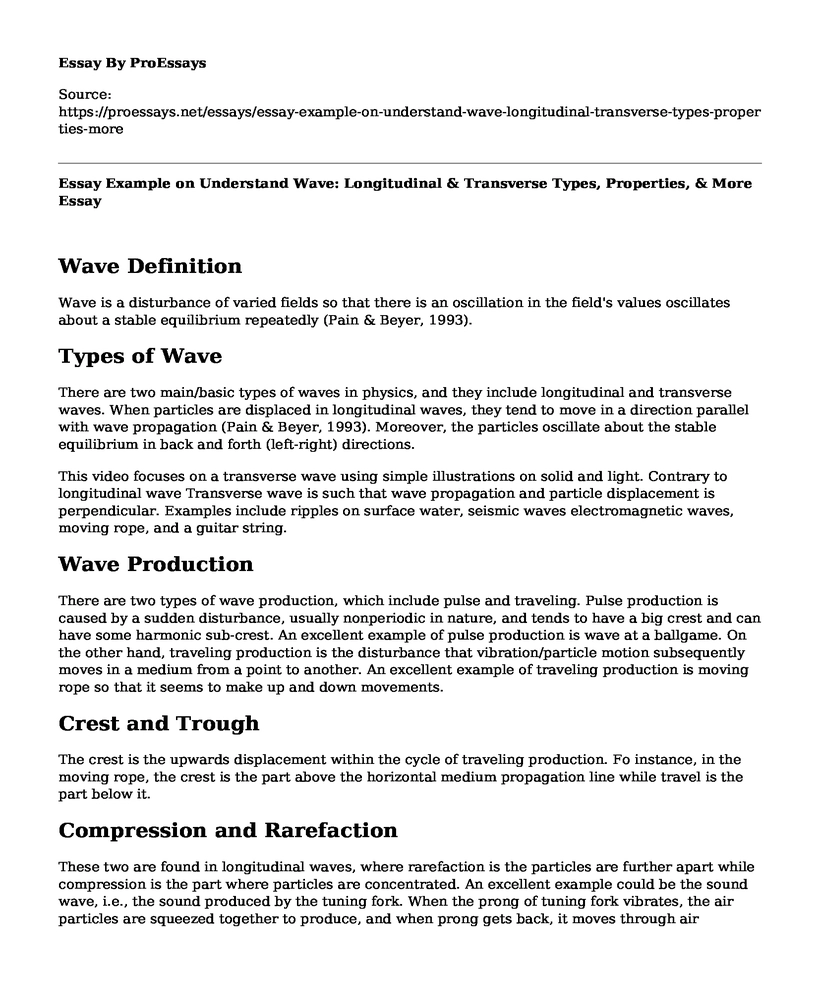Wave Definition
Wave is a disturbance of varied fields so that there is an oscillation in the field's values oscillates about a stable equilibrium repeatedly (Pain & Beyer, 1993).
Types of Wave
There are two main/basic types of waves in physics, and they include longitudinal and transverse waves. When particles are displaced in longitudinal waves, they tend to move in a direction parallel with wave propagation (Pain & Beyer, 1993). Moreover, the particles oscillate about the stable equilibrium in back and forth (left-right) directions.
This video focuses on a transverse wave using simple illustrations on solid and light. Contrary to longitudinal wave Transverse wave is such that wave propagation and particle displacement is perpendicular. Examples include ripples on surface water, seismic waves electromagnetic waves, moving rope, and a guitar string.
Wave Production
There are two types of wave production, which include pulse and traveling. Pulse production is caused by a sudden disturbance, usually nonperiodic in nature, and tends to have a big crest and can have some harmonic sub-crest. An excellent example of pulse production is wave at a ballgame. On the other hand, traveling production is the disturbance that vibration/particle motion subsequently moves in a medium from a point to another. An excellent example of traveling production is moving rope so that it seems to make up and down movements.
Crest and Trough
The crest is the upwards displacement within the cycle of traveling production. Fo instance, in the moving rope, the crest is the part above the horizontal medium propagation line while travel is the part below it.
Compression and Rarefaction
These two are found in longitudinal waves, where rarefaction is the particles are further apart while compression is the part where particles are concentrated. An excellent example could be the sound wave, i.e., the sound produced by the tuning fork. When the prong of tuning fork vibrates, the air particles are squeezed together to produce, and when prong gets back, it moves through air particles where there is low pressure.
Wavelength and Amplitude
Wavelength is the distance between the peaks of crest-to-next-crest or trough-to-next-trough (in the transverse wave). In a longitudinal wave, the wavelength is the distance between two compressions points. Amplitude is the height/magnitude from the equilibrium position to the trough or crest.
Principle of Superposition
The principle states that the sum of the stimuli/response caused by two linear systems if equal to the same that could be caused by each of the systems. Both waves meet making an amplitude, which is similar to the sum of their magnitude.
Constructive and Destructive Interference
Waves can move through each other, whether in the different or the same directions except for solid objects. Following the principle of superposition adding the waves' amplitude, there are different results in varied waves. Constructive interference occurs when superposing waves have a phase difference, an even multiple of (π) 180 degrees. Naturally, it occurs when the crest of one wave meets the other (Xie et al., 2017). Destructive interference is formed when the crest of one wave meets the trough of another or have they have an odd multiple of (π).
Natural Frequency, Standing Wave, and Resonance
While frequency is provided as follows
Frequency= speed/wavelength
f = v/ λ
Every object is said to have a natural frequency which is the frequency at which an object vibrates when upon hitting. Some objects do vibrate when their frequency is higher than the human frequency range.
A standing wave is the wave with different amplitude profile spaces but oscillates simultaneously (constant time unique spaces of amplitude) (Wang et al., 2017). For instance, For example, Gaussian two waves travel in the opposite direction, causing a wave to have a sum of the waves' amplitudes. Moreover, different spaces occur as both waves move from crest to the next crest or trough to the next trough.
Resonance is when an object forces another object to vibrate if the 1st object has the same natural frequency with the 2nd object; this forms round sound and applicable in a musical instrument.
Nodes and Antinodes
Nodes are the points that are located along with the medium, and they appear to be stationary. However, the nodes which are displaced into the maximum point (say the peak of crest or trough) are called antinodes.
References
Pain, H. J., & Beyer, R. T. (1993). The physics of vibrations and waves.
Wang, Z., Li, M., & Wang, R. (2017). Resonance beyond frequency-matching: multidimensional resonance. New Journal of Physics, 19(3), 033012. https://iopscience.iop.org/article/10.1088/1367-2630/aa6275/pdf
Xie, C., Kendrick, B. K., Yarkony, D. R., & Guo, H. (2017). Constructive and destructive interference in nonadiabatic tunneling via conical intersections. Journal of chemical theory and computation, 13(5), 1902-1910.
Cite this page
Essay Example on Understand Wave: Longitudinal & Transverse Types, Properties, & More. (2023, Sep 04). Retrieved from https://proessays.net/essays/essay-example-on-understand-wave-longitudinal-transverse-types-properties-more
If you are the original author of this essay and no longer wish to have it published on the ProEssays website, please click below to request its removal:
- Drugs Dosage
- Solving Sudoku Research
- Learning Physics and Science Concepts Essay
- The Supply and Use of Water in Abu Dhabi Paper Example
- Atchafalaya River Essay Example
- Essay Example on Exploring the Appalachian Mountains: An Ancient Landscape
- A Sense-Datum: Mind-Dependent Objects in Perception - Essay Sample







